Protein and fat intake impact on growth of primary school girls in Kerman, Iran
- PMID: 38961253
- PMCID: PMC11222480
- DOI: 10.1038/s41598-024-66001-4
Protein and fat intake impact on growth of primary school girls in Kerman, Iran
Abstract
The school age period is characterized by significant physical and intellectual growth, necessitating the monitoring of macronutrient intake and its impact on weight and height. The objective of this study is to investigate the association between the quality and quantity of protein and fat consumption with anthropometric indices in primary school girls in Kerman. This cross-sectional analysis was conducted on primary school girls aged 6-12 (n 330) from ten schools in Kerman, Iran. A validated and reliable dish-based 185-item food frequency questionnaire was used. We calculated the amount of proteins and fats as the percentage of daily calories and grams per day. Plant-based and animal-based proteins were used to assess the protein quality. To assess the fat quality, we considered trans fatty acids (TFA), cholesterol, vegetable oils, solid vegetable oils, animal oils, omega-6 Polyunsaturated fatty acids (PUFAs), omega-3 PUFA, and (PUFAs + Monounsaturated fatty acids (MUFAs))/Saturated fatty acids (SFAs), PUFAs/SFA, and (MUFA + PUFA)/(SFA + TFA). There was a significant positive association between height-for-age z-score (HAZ) and plant protein (p < 0.001) and vegetable oils (p = 0.038) after adjustment. In higher tertiles of animal protein, weight-for-age z-score (WAZ) (p = 0.024) were significantly higher. A significant positive association was observed between omega-3 PUFA and mid-upper arm circumference (MUAC) (p = 0.039) and BMI-for-age z-score (BAZ) (p = 0.016). Our study emphasizes the importance of monitoring protein and fat intake in primary school girls for optimal growth. Positive associations were found between plant-based protein, vegetable oils and HAZ, as well as animal protein and WAZ, highlighting the impact of protein quality on growth indicators.
Keywords: Anthropometric indices; Fat; Kerman; Protein; Quality; Quantity; Student.
© 2024. The Author(s).
Conflict of interest statement
The authors declare no competing interests.
Figures




Similar articles
-
Association between quality and quantity of carbohydrate intake with selected anthropometric indices among primary school girls in Kerman city, Iran: a cross-sectional study.BMC Pediatr. 2024 Apr 24;24(1):267. doi: 10.1186/s12887-024-04739-6. BMC Pediatr. 2024. PMID: 38658854 Free PMC article.
-
Associations of diet quality and food consumption with serum biomarkers for lipid and amino acid metabolism in Finnish children: the PANIC study.Eur J Nutr. 2024 Mar;63(2):623-637. doi: 10.1007/s00394-023-03293-8. Epub 2023 Dec 21. Eur J Nutr. 2024. PMID: 38127151 Free PMC article.
-
Development of a food-exchange model to replace saturated fat with MUFAs and n-6 PUFAs in adults at moderate cardiovascular risk.J Nutr. 2014 Jun;144(6):846-55. doi: 10.3945/jn.114.190645. Epub 2014 Apr 9. J Nutr. 2014. PMID: 24717370 Clinical Trial.
-
Foods with a high fat quality are essential for healthy diets.Ann Nutr Metab. 2009;54 Suppl 1:15-24. doi: 10.1159/000220823. Epub 2009 Jul 30. Ann Nutr Metab. 2009. PMID: 19641346 Review.
-
[CONSENSUS ON FATS AND OILS IN THE DIET OF S ISH ADULTS; POSITION PAPER OF THE SPANISH FEDERATION OF FOOD, NUTRITION AND DIETETICS SOCIETIES].Nutr Hosp. 2015 Aug 1;32(2):435-77. doi: 10.3305/nh.2015.32.2.9202. Nutr Hosp. 2015. PMID: 26268073 Review. Spanish.
References
-
- de Onis M. Child growth and development. In: de Pee S, Taren D, Bloem M, editors. Nutrition and Health in a Developing World. Nutrition and Health. Humana Press; 2017.
MeSH terms
Substances
LinkOut - more resources
Full Text Sources
Medical

